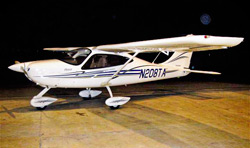 The first Tecnam light sport aircraft to use both carbon fiber composite material and metal is expected to arrive in the United States this month from the factory in Italy. Tecnam officials in Richmond, Va., said using carbon fiber for the fuselage and metal for the wings and stabilator on the Tecnam P2008 will continue to make the aircraft easy to repair, yet take advantage of carbon fiber for the fuselage. Previous models have been all-metal designs.
The first Tecnam light sport aircraft to use both carbon fiber composite material and metal is expected to arrive in the United States this month from the factory in Italy. Tecnam officials in Richmond, Va., said using carbon fiber for the fuselage and metal for the wings and stabilator on the Tecnam P2008 will continue to make the aircraft easy to repair, yet take advantage of carbon fiber for the fuselage. Previous models have been all-metal designs.
Most repairs, such as dings in the wing or tail from storage in a hangar, occur on the wing and stabilator, a Tecnam salesman said. The official indicated metal is easier to repair than composite material. Yet composites offer smoother, more elegant design possibilities.
Easy repair also was cited as the reason for going from a steerable nosewheel to a castering nosewheel. Parts used in the steerable nosewheel took abuse during student training and required frequent repair. Many models of light sport aircraft, and fully certified trainers and four-place aircraft throughout the industry successfully use castering nosewheels.
The P2008 carries 29 gallons of fuel in the wing box behind the main spar to preserve the integrity of the tanks in the event of a crash landing, and to minimize the potential for fire, a company press release said.
Also new to the P2008 is a baggage storage area, a feature requested by previous customers.



